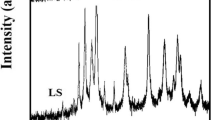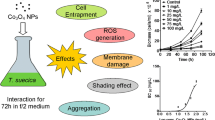Abstract
The toxicity of ZnO nanoparticles (NPs) has been widely investigated because of their extensive use in consumer products. The mechanism of the toxicity of ZnO NPs to algae is unclear, however, and it is difficult to differentiate between particle-induced toxicity and the effect of dissolved Zn2+. In the work discussed in this paper we investigated particle-induced toxicity and the effects of dissolved Zn2+ by using the chiral perturbation approach with dichlorprop (DCPP) as chiral perturbation factor. The results indicated that intracellular zinc is important in the toxicity of ZnO NPs, and that ZnO NPs cause oxidative damage. According to dose–response curves for DCPP and the combination of ZnO NPs with (R)-DCPP or (S)-DCPP, the toxicity of DCPP was too low to perturb the toxicity of ZnO NPs, so DCPP was suitable for use as chiral perturbation factor. The different glutathione (GSH) content of algal cells exposed to (R)-DCPP or (S)-DCPP correlated well with different production of reactive oxygen species (ROS) after exposure to the two enantiomers. Treatment of algae with ZnO NPs and (R)-DCPP resulted in reduced levels of GSH and the glutathione/oxidized glutathione (GSH/GSSG) ratio in the cells compared with the control. Treatment of algae with ZnO NPs and (S)-DCPP, however, resulted in no significant changes in GSH and GSH/GSSG. Moreover, trends of variation of GSH and GSH/GSSG were different when algae were treated with ZnSO4·7H2O and the two enantiomers. Overall, the chiral perturbation approach revealed that NPs aggravated generation of ROS and that released Zn2+ and NPs both contribute to the toxicity of ZnO NPs.

explore causes of the toxicity of ZnO NPs by chiral perturbation approach







Similar content being viewed by others
References
Gottschalk F, Nowack B (2011) The release of engineered nanomaterials to the environment. J Environ Monit 13:1145–1155
Pikethly MJ (2004) Nanomaterials—the driving force. Materialstoday 7:20–29
Danovaro R, Bongiorni L, Corinaldesi C, Giovannelli D, Damiani E, Astolfi P, Greci L, Pusceddu A (2008) Sunscreens cause coral bleaching by promoting viral infections. Environ Health Perspect 116:441–447
Wong SWY, Leung PTY, Djurišić AB, Leung KMY (2010) Toxicities of nano zinc oxide to five marine organisms: influences of aggregate size and ion solubility. Anal Bioanal Chem 396:609–618
Franklin NM, Rogers NJ, Apte SC, Batley GE, Gadd GE, Casey PS (2007) Comparative toxicity of nanoparticulate ZnO, bulk ZnO, and ZnCl2 to a freshwater microalga (Pseudokirchneriella subcapitata): the importance of particle solubility. Environ Sci Technol 41:8484–8490
Aruoja V, Dubourguier H-C, Kasemets K, Kahru A (2009) Toxicity of nanoparticles of CuO, ZnO and TiO2to microalgae Pseudokirchneriella subcapitata. Sci Total Environ 407:1461–1468
Ji J, Long Z, Lin D (2011) Toxicity of oxide nanoparticles to the green algaeChlorellasp. Chem Eng J 170:525–530
Mingsheng X, Li J, Hanagata N, Huanxing S, Chen H, Fujita D (2013) Challenge to assess the toxic contribution of metal cation released from nanomaterials for nanotoxicology–the case of ZnO nanoparticles. Nanoscale 5:4763–4769
Blinova I, Ivask A, Heinlaan M, Mortimer M, Kahru A (2009) Ecotoxicity of nanoparticles of CuO and ZnO in natural water. Environ Pollut 158:41–47
Wiench K, Wohlleben W, Hisgen V, Radke K, Salinas E, Zok S, Landsiedel R (2009) Acute and chronic effects of nano- and non-nano-scale TiO2 and ZnO particles on mobility and reproduction of the freshwater invertebrate Daphnia magna. Chemosphere 76:1356–1365
Li M, Lin D, Zhu L (2013) Effects of water chemistry on the dissolution of ZnO nanoparticles and their toxicity to Escherichia coli. Environ Pollut 173:97–102
Zhu X, Zhu L, Duan Z, Qi R, Li Y, Lang Y (2008) Comparative toxicity of several metal oxide nanoparticle aqueous suspensions to Zebrafish (Danio rerio) early developmental stage. J Environ Sci Health A 43:278–284
Hao L, Chen L (2012) Oxidative stress responses in different organs of carp (Cyprinus carpio) with exposure to ZnO nanoparticles. Ecotoxicol Environ Saf 80:103–110
Sharifi S, Behzadi S, Laurent S, Laird Forrest M, Stroeve P, Mahmoudi M (2012) Toxicity of nanomaterials. Chem Soc Rev 41:2323–2343
Pisanic TR, Jin S, Shubayev VI (2009) Nanotoxicity: From in vivo and In vitro models to health risks. John Wiley & Sons, Ltd., London, UK, pp 397–425
De Berardis B, Civitelli G, Condello M, Lista P, Pozzi R, Arancia G, Meschini S (2010) Exposure to ZnO nanoparticles induces oxidative stress and cytotoxicity in human colon carcinoma cells. Toxicol Appl Pharmacol 246:116–127
Ma H, Williams PL, Stephen A (2013) Diamond Ecotoxicity of manufactured ZnO nanoparticles-A review. Environ Pollut 172:76–85
Lv J, Zhang S, Luo L, Han W, Zhang J, Yang K, Christie P (2012) Dissolution and Microstructural Transformation of ZnO Nanoparticles under the Influence of Phosphate. Environ Sci Technol 46:7215–7221
Li M, Zhu L, Lin D (2012) oxicity of ZnO Nanoparticles toEscherichia coli: Mechanism and the Influence of Medium Components. Environ Sci Technol 45:1977–1983
Maynard AD, Aitken RJ, Butz T, Colvin V, Donaldson K, Oberdörster G, Philbert MA, Ryan J, Seaton A, Stone V, Tinkle SS, Tran L, Walker NJ, Warheit DB (2006) Safe handling of nanotechnology. Nature 444:267–269
Foyer CH, Noctor G (2011) Ascorbate and glutathione: the heart of the redox hub. Plant Physiol 155:2–18
Sies H (1999) Glutathione and its role in cellular functions. Free Radic Biol Med 27:916–921
Chen H, Chen J, Guo Y, Wen Y, Liu J, Liu W (2012) Evaluation of the role of the glutathione redox cycle in Cu(II) toxicity to green algae by a chiral perturbation approach. Aquat Toxicol 120–121:19–26
Garrison AW (2006) Probing the enantioselectivity of chiral pesticides. Environ Sci Technol 40:16–23
Wen YZ, Li CD, Fang ZH, Zhuang SL, Liu WP (2011) Elucidation of the enantioselective enzymatic hydrolysis of chiral herbicide dichlorprop methyl by chemical modification. J Agric Food Chem 59:1924–1930
Wang Z, Li J, Zhao J, Xing B (2011) Toxicity and Internalization of CuO Nanoparticles to Prokaryotic Alga Microcystis aeruginosaas Affected by Dissolved Organic Matter. Environ Sci Technol 45:6032–6040
Rahman I, Kode A, Biswas SK (2006) Assay for quantitative determination of glutathione and glutathione disulfide levels using enzymatic recycling method. Nat Protoc 1:3159–3164
Wen Y, Chen H, Shen C, Zhao M, Liu W (2011) Enantioselectivity Tuning of Chiral Herbicide Dichlorprop by Copper: Roles of Reactive Oxygen Species. Environ Sci Technol 45:4778–4784
Ma M, Zhu W, Wang Z, Witkamp GJ (2003) Accumulation, assimilation and growth inhibition of copper on freshwater alga (Scenedesmus subspicatus86.81 SAG) in the presence of EDTA and fulvic acid. Aquat Toxicol 63:221–228
Blumerisinger M, Meindl D, Loos E (1983) Cell wall composition of chlorococcal algae. Phytochemistry 22:1603–1604
Sayeed I, Parvez S, Pandey S, Bin-Hafeez B, Haque R, Raisuddin S (2003) Oxidative stress biomarkers of exposure to deltamethrin in freshwater fish, Channa punctatus Bloch. Ecotoxicol Environ Saf 56:295–301
Acknowledgements
The authors are very grateful to the Project of Science and Technology Department of Zhejiang Province (2012C37058) and the Key Innovation Team of Science and Technology in Zhejiang Province (2010R50018) for financial support.
Author information
Authors and Affiliations
Corresponding author
Additional information
Published in the topical collection Euroanalysis XVII (The European Conference on Analytical Chemistry) with guest editor Ewa Bulska.
Electronic supplementary material
Below is the link to the electronic supplementary material.
ESM 1
Supporting information, available free of charge via the internet, includes the characteristics and TEM image of the ZnO NPs, dose–response fitting curves for the effects of ZnO NPs and ZnSO4 on algae, dose–response fitting curves for the effects of (R)-DCPP and (S)-DCPP on algae and on the ultrastructure of the algae. (PDF 5.98 mb)
Rights and permissions
About this article
Cite this article
Zhou, H., Wang, X., Zhou, Y. et al. Evaluation of the toxicity of ZnO nanoparticles to Chlorella vulgaris by use of the chiral perturbation approach. Anal Bioanal Chem 406, 3689–3695 (2014). https://doi.org/10.1007/s00216-014-7773-0
Received:
Revised:
Accepted:
Published:
Issue Date:
DOI: https://doi.org/10.1007/s00216-014-7773-0




